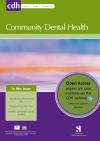Community Dental Health

- Cover Date:
- December 2014
- Print ISSN:
- 0265 539X
- Vol:
- 31
- Issue:
- 4
Trends and predictors of primary dental care health services for adults in Israel
© BASCD 2014 doi:10.1922/CDH_3335Zlotnick07
Trends and predictors of primary dental care health services for adults in Israel
C. Zlotnick, O. Baron-Epel, S. Paul Zusman and L. Keinan-Boker
Objectives: Guided by the Andersen-Aday Behavioral Model of Health Care Utilization, this study compared primary dental care use trends between 2000 and 2010, and differences in primary dental care use between Israel’s two largest ethnic groups, Jews and Arabs. Methods: Two waves (years 2000 and 2010) of existing cross-sectional data collected from a nationwide sample on the population’s health knowledge, attitudes and practice were used. This study uses the sample of Israeli-Jews (n=2806) from 2000; and the nationally representative sample of Israeli-Jews (n=2539) and Israeli-Arabs (n=1723) from 2010. Results: Primary dental care use increased between 2000 and 2010 in Israel. Israelis who had at least a high school diploma, average or higher income, no dental pain and reported flossing their teeth were more likely to use primary dental care, but this was true of fewer Israeli-Arabs than Israeli-Jews. Other variables, associated with use of primary dental care but differing by ethnic group, were: being older than 65 years, being a native-born Israeli, employment, and health risk factors such as smoking and obesity. Conclusions: As with other western societies and as indicated by the model’s three factors (i.e., predisposing, enabling and reinforcing/need), disparities in primary dental care use were found based on income (i.e., enabling); immigrants and ethnic minority status (i.e., predisposing), and health risk such as smoking (i.e., reinforcing/need). It is evident that health promotion activities are needed to target specific population subgroups to reduce disparities in primary dental care utilisation.
Key words: oral hygiene, oral health behaviour, oral health promotion, socioeconomic factors, inequalities, Israel
- Article Price
- £15.00
- Institution Article Price
- £
- Page Start
- 212
- Page End
- 218
- Authors
- C. Zlotnick, O. Baron-Epel, S. Paul Zusman, L. Keinan-Boker
Articles from this issue
- Title
- Pg. Start
- Pg. End
- The European Association of Dental Public Health conference resolution on the control of e-cigarettes; Or “You have to be a bit crazy to carry on smoking conventional cigarettes when there are e-cigarettes availableâ€
- 194
- 195
- Weighing up the Weighted Case Mix Tool (WCMT): a psychometric investigation using confirmatory factor analysis
- 200
- 206
- Dentists’ views on the effects of changing economic conditions on dental services provided for children and adolescents in Iceland
- 219
- 223
- Utilisation of oral health services provided by non-dental health practitioners in developed countries: a review of the literature
- 224
- 233
- The impact of oral health status on the Oral Health-Related Quality of Life (OHRQoL) of 12-year-olds from children’s and parents’ perspectives
- 240
- 244
